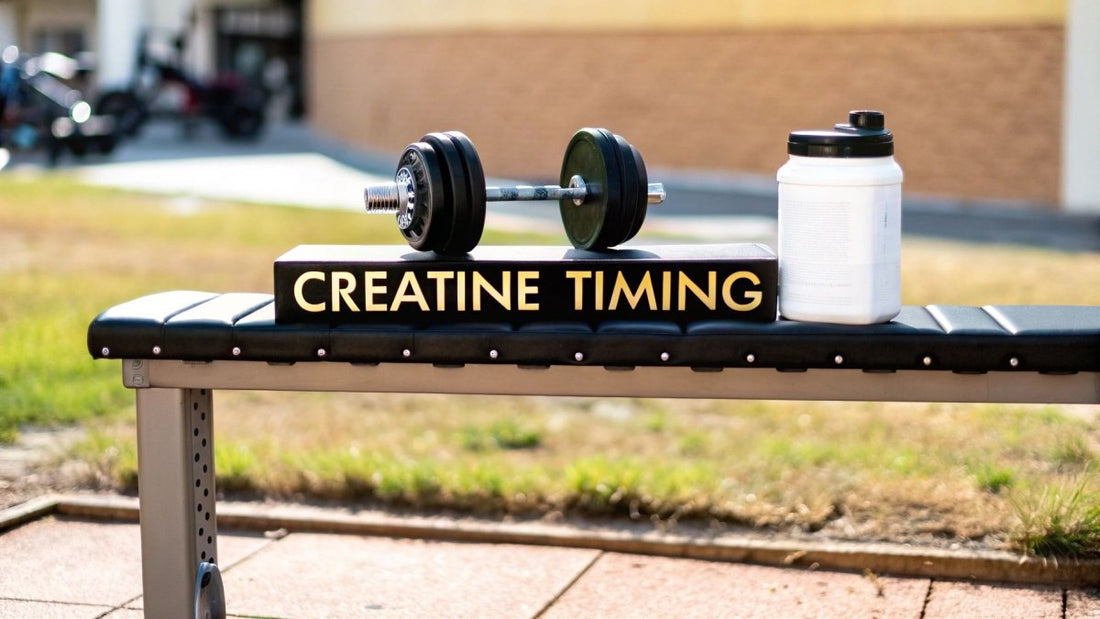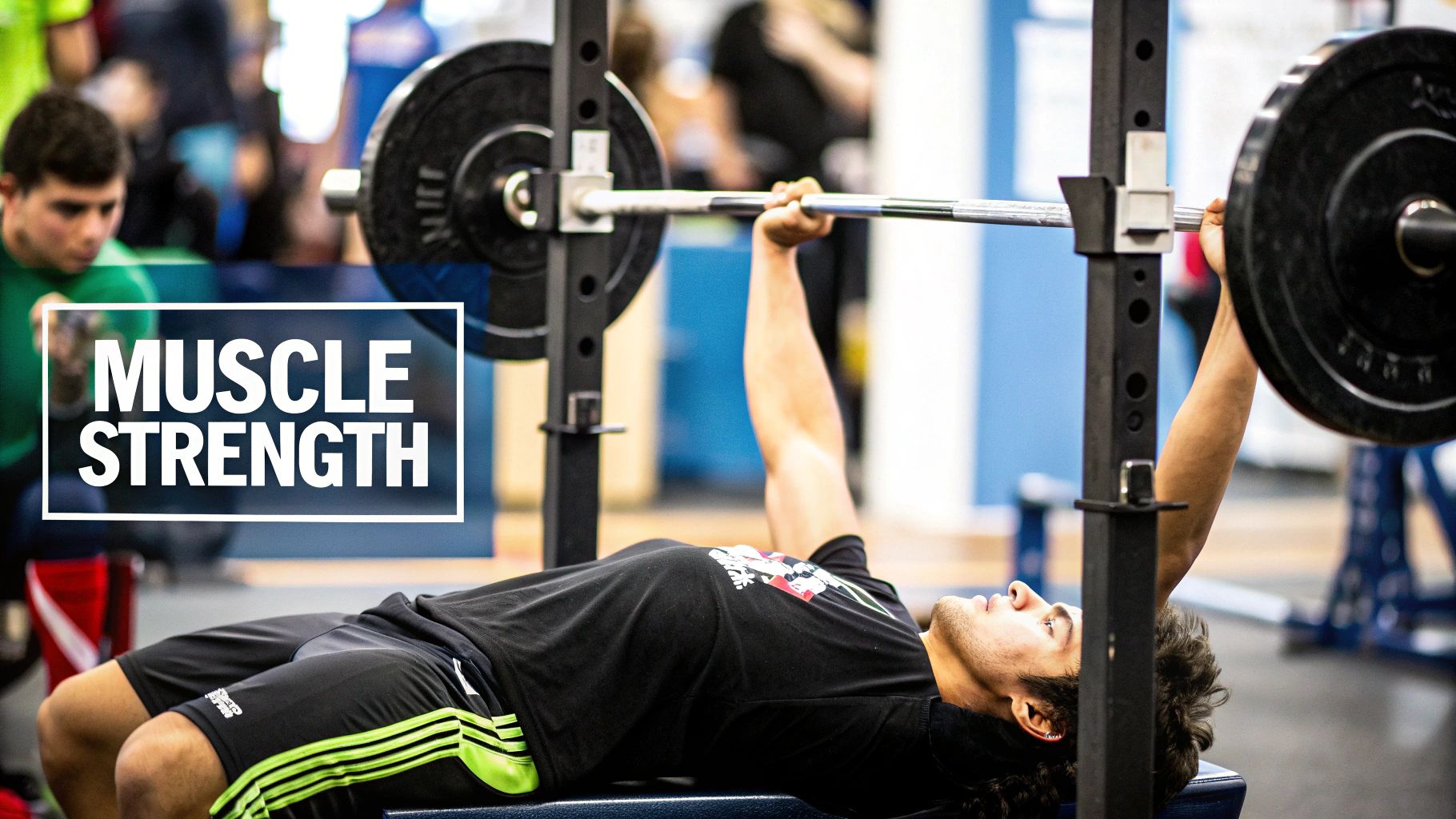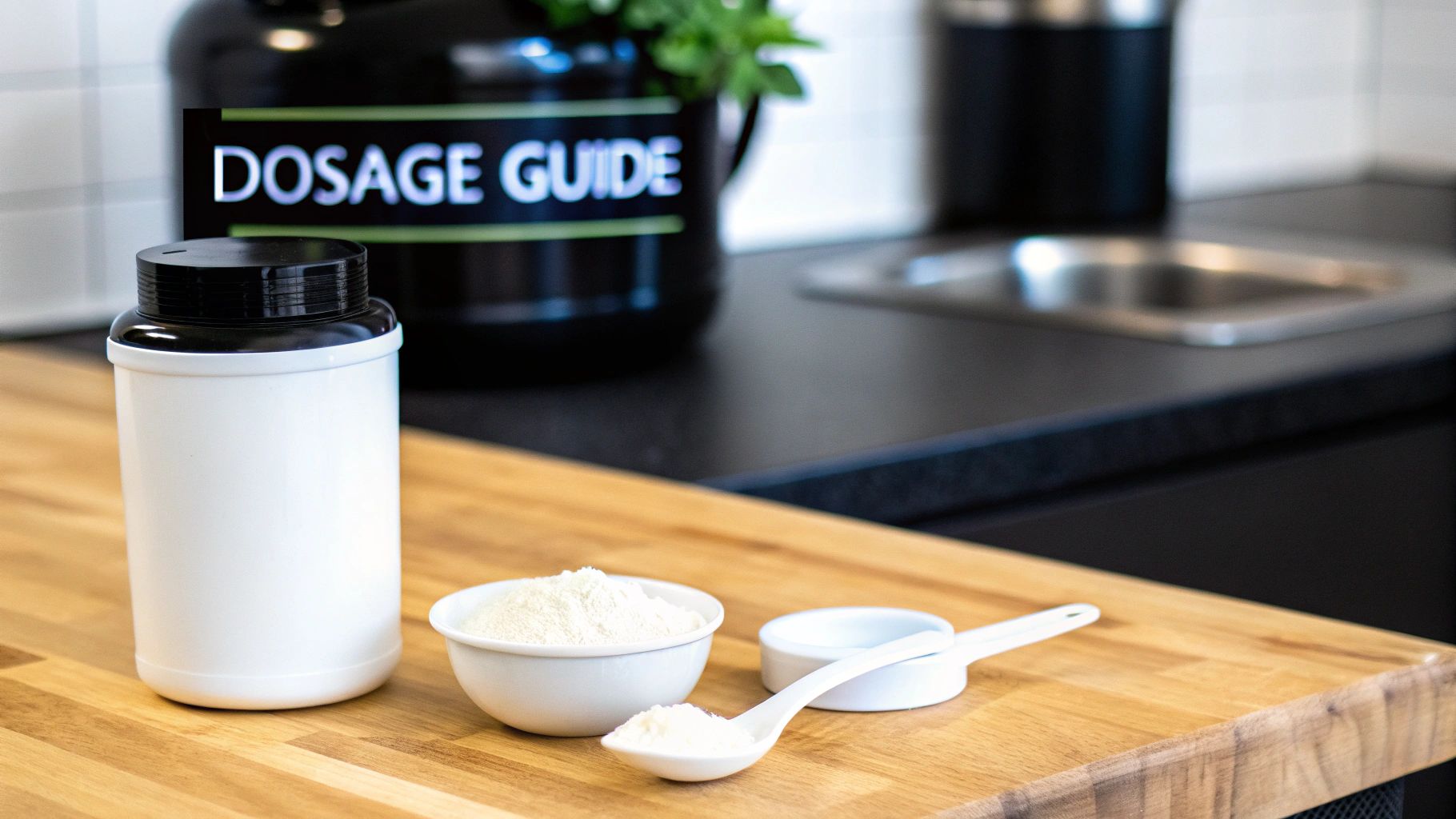
Should I Take Creatine Before or After Workout? Find Out Now
Share
So, what’s the final verdict on creatine timing? When should you actually take it?
Here’s the simple, honest truth: the best time to take creatine is whenever you’ll actually remember to take it. For the vast majority of people, the performance difference between taking it before or after a workout is going to be incredibly small. The real key to making creatine work for you is keeping your muscles fully saturated with it, day in and day out.
Think of it like watering a plant. It doesn't matter much if you water it in the morning or the evening; what matters is that you water it consistently. Skip a few days, and the plant wilts. It's the same idea with creatine—consistency is what fuels your results.
While some studies suggest a slight advantage to taking it post-workout, this shouldn't overshadow the golden rule: just take it daily.

This image nails the fundamentals. Stick to the recommended 3-5 grams per day, and don't stress too much about the exact timing. Both pre- and post-workout are perfectly fine choices.
To break it down even further, here’s a quick summary to help you decide what might work best for your routine.
Quick Guide to Creatine Timing
| Timing | Potential Benefit | Best For | Key Takeaway |
|---|---|---|---|
| Pre-Workout | Immediate ATP availability for your workout session. | Individuals looking for a potential boost in power and reps during their training. | Your muscles use creatine to make energy. Taking it beforehand tops off the tank right when you need it. |
| Post-Workout | Enhanced muscle uptake and recovery alongside a post-workout meal. | People focused on maximizing muscle growth and recovery over the long term. | Your muscles are like a sponge after training, making it an ideal time for nutrient absorption, including creatine. |
Ultimately, the science points to a small edge for post-workout consumption, but real-world results are built on the foundation of consistency. Pick the time that fits seamlessly into your daily life, and stick with it.
How Creatine Actually Powers Your Muscles

To really get to the bottom of the whole “creatine before or after a workout” question, we first need to pull back the curtain on what it’s actually doing in your body.
Think of your muscles like a high-performance engine. For those quick, explosive movements—like a heavy squat or an all-out sprint—they need a very specific, high-octane fuel. That fuel is a molecule called adenosine triphosphate (ATP).
The catch? Your body only keeps a tiny amount of ATP on hand, just enough for a few seconds of intense work. Once you use it, it becomes a sort of "drained battery" called adenosine diphosphate (ADP). This is where creatine swoops in to save the day.
Creatine's main job is to act like a super-fast charging pack for your muscles. When you supplement, your body stores it as creatine phosphate. This compound can instantly lend its phosphate molecule to the used-up ADP, rapidly turning it back into fresh, usable ATP.
The Bottom Line: Creatine isn’t a stimulant like caffeine. It’s an energy recycler. It helps you rapidly regenerate your body's most explosive fuel source (ATP) so you can push harder for longer.
Why Saturation is the Real Goal
This rapid recycling system is the magic behind squeezing out that extra one or two reps when a set gets tough. By keeping your creatine stores full, you make sure this ATP regeneration process is firing on all cylinders. This is also why when you take it is far less important than taking it consistently.
Your goal is to keep your muscle creatine levels fully "saturated"—basically, topped off. It’s a lot like keeping your car’s gas tank full. It doesn’t really matter if you fill up in the morning or at night, as long as you never let the tank run dry.
Taking your 3-5 grams daily ensures your muscles have a ready supply of phosphate to rebuild ATP the second you need it. We cover this in more detail in our complete guide on creatine for muscle growth.
Ultimately, supplementing with creatine isn't about getting an immediate pre-workout jolt. It's a long-term strategy focused on building and maintaining those crucial muscle stores over time. Once you grasp this, it becomes clear why the research often finds such tiny differences between pre- and post-workout timing.
The Scientific Case for Post-Workout Creatine

While just taking creatine consistently is the most important thing, a strong case can be made for timing it after you train. This whole idea hinges on what’s happening inside your body right after a tough workout.
Think of your muscles post-exercise as dry sponges, ready and waiting to soak up nutrients to begin the repair and growth process. Your blood is pumping, and your muscle cells are extra receptive to insulin, the hormone that acts like a key, unlocking cells to let nutrients in.
This heightened sensitivity creates a perfect opportunity. By taking creatine after your workout—especially with some carbs and protein—you can piggyback on the natural insulin response. The creatine gets a direct, high-speed escort right into your muscle cells where it’s needed most. It’s all about working with your body’s physiology for better absorption. Our guide on when to take creatine for best results dives deeper into this.
The Edge in Muscle Growth
So, does this timing trick actually show up in the real world? The research suggests it does, giving post-workout timing a slight but noticeable edge, specifically for building muscle.
When it comes to strength gains, the difference between pre- and post-workout timing seems pretty negligible. But for hypertrophy (the sciencey term for muscle growth), the story is a bit different.
A detailed review of multiple studies found that while both pre- and post-workout creatine significantly boosted strength, post-exercise intake was slightly superior for increasing muscle mass.
For example, one study found that lifters taking creatine after their workouts increased their chest press strength by 36% over several months. The pre-workout group? They still saw a fantastic 30% increase, but the post-workout crew consistently showed that small advantage in building actual muscle. You can dig into the full research on creatine timing effects yourself to see the numbers.
At the end of the day, the evidence points in one direction: if packing on as much muscle as possible is your main goal, taking your creatine after you train is a smart, science-backed move. It simply aligns with your body's natural recovery state to get the most out of every scoop.
The Strategic Argument for Pre-Workout Creatine
https://www.youtube.com/embed/gOhWn1a8zWE
On the other side of this debate, you have the straightforward, practical logic of taking creatine before you train. The idea is simple: if creatine is your high-octane fuel for explosive movements, why not top off the tank right before you hit the gas? This whole approach is about being primed for peak performance the second you walk into the gym.
The theory is that taking your creatine 30-60 minutes before you start lifting ensures it's readily available for your muscles during the session. It's like filling up your car with gas right before a long road trip, not after you've already pulled back into the driveway. You're giving your muscles maximum access to the creatine phosphate they need to rapidly regenerate ATP energy.
This "immediate fuel" hypothesis suggests a direct, tangible benefit to your workout. That extra rep you grind out on the bench press or that last explosive push during a sprint? That could be the direct result of having your energy stores perfectly peaked right when you need them most.
Does the Science Support Pre-Workout Timing?
While the post-workout "anabolic window" gets a ton of hype, the research looking at pre-workout timing shows that the benefits are still very real. In fact, many studies find that when it comes to raw strength gains, there's often little to no significant difference between taking creatine before or after training. Both approaches lead to impressive results.
The most important thing, at the end of the day, is that your muscles are fully saturated with creatine. Taking it pre-workout is simply one strategy to ensure the fuel is there at the exact point of action. Many lifters like to stack it with other supplements, and you can learn more by checking out our guide on mixing creatine with pre-workout.
Key Insight: The argument for pre-workout timing isn't so much about long-term muscle building as it is about maximizing in-the-moment performance. The goal is to make sure your ATP energy cycle has everything it needs to fire on all cylinders from your very first warm-up set to your final, gut-busting rep.
Is "Workout Proximity" the Real Answer?

What if we’ve been asking the wrong question all along? The whole "before vs. after" debate might be missing the bigger picture. A more practical way to look at it is that the most critical factor isn't which side of the workout you land on, but simply how close you take creatine to your training session.
This idea of "workout proximity" neatly sidesteps the debate. Taking creatine somewhere in that window—just before you start or right after you finish—leverages your body's natural response to exercise. Think of the increased blood flow from training as an express delivery service, rushing nutrients like creatine straight to your hard-working muscles.
The real enemy here isn’t pre- or post-workout timing. It's taking your creatine randomly, completely disconnected from your training. Downing your creatine at 9 AM for a 7 PM gym session just doesn't pack the same punch as timing it around the main event.
Capitalizing on the Training Window
This approach makes things a lot simpler. Your goal is just to get creatine into your system when your muscles are primed and ready to soak it up.
And the science is starting to catch up with this idea. A 2022 study really drove this point home, showing that athletes who took creatine close to their workouts got significantly better results than those who took it hours before or after.
The group that timed their creatine around their workout saw a 24.6% jump in intramuscular creatine and a 16.8% increase in phosphocreatine. This translated directly into more lean muscle and bigger, stronger type II muscle fibers.
These numbers are pretty telling. Aligning your creatine dose with your workout seems to be a powerful strategy for saturating your muscles and getting the most out of every rep. You can dive into the full study on creatine timing and muscle adaptation to see the data for yourself.
So, maybe it's time to stop worrying about the minute details of before vs. after. Just focus on taking it around your workout, and you'll be on the right track.
So, Should You Even Worry About Creatine Timing?
After going back and forth on pre- versus post-workout, let's zoom out for a second. Is all this debate over timing something you really need to stress about?
For most of us, the answer is a resounding no.
Getting bogged down in the perfect minute to take your creatine is a classic case of missing the forest for the trees. The real magic of creatine comes from consistency, not from nailing a specific 5-minute window around your workout.
Think of it this way: your overall training plan, your diet, and just showing up every day are the big, heavy lifts. Worrying about precise creatine timing is like debating which brand of chalk to use. It's a tiny detail that only matters once everything else is absolutely dialed in. The fundamentals are what build your foundation.
Who Really Benefits from Perfect Timing?
This becomes crystal clear when you look at different groups of people. Take older adults, for example. The research is overwhelming that combining creatine with resistance training is a game-changer for strength and muscle mass, and the exact timing barely registers.
A massive 32-week study on older adults found that both pre- and post-workout creatine groups saw nearly identical gains in strength and muscle. The real story? Both groups blew the placebo group out of the water, proving that just taking it consistently was the key driver of their results.
The message here is simple: creatine works wonders when paired with exercise. A 2021 study confirmed this yet again, showing that older adults got just as strong whether they took their creatine before or after their sessions. You can see the full study on creatine timing in older adults for yourself.
So, whether you're a weekend warrior, a dedicated athlete, or just someone trying to get stronger, your focus should be on two things: hitting your workouts and taking your creatine every single day. Nail those, and you'll be miles ahead of anyone still sweating the small stuff.
Frequently Asked Questions About Creatine
Even after you've got the science down, a few practical questions always come up when you first start taking creatine. Nailing these small details can make a huge difference in how well it works for you. Let's tackle some of the most common ones.
Should I Take Creatine on Rest Days?
Absolutely. Consistency is everything with creatine. Taking your regular 3-5 gram dose on your off days is crucial for keeping your muscle stores topped off.
Think of it like keeping a gas tank full. You wouldn't drain it and only fill it up right before a long drive, would you? The same logic applies here—stay saturated so you're ready to go for your next training session.
Does It Matter What I Mix Creatine With?
It can, and this is a great way to optimize it. Taking creatine with carbohydrates can give its absorption a serious boost.
Carbs cause a spike in insulin, and insulin basically acts like a key that unlocks your muscle cells, helping to shuttle creatine inside much more effectively. A simple glass of juice or adding it to your post-workout shake that already has carbs and protein is a perfect strategy.
Key Takeaway: While we can debate the fine points of pre- vs. post-workout timing, taking creatine on your rest days is non-negotiable if you want to maintain muscle saturation and get the results you're after.
Do I Really Need a Creatine Loading Phase?
Nope, it's not a requirement at all—think of it more like an accelerator. A loading phase gets you to the finish line faster, but it isn't mandatory.
Loading involves taking about 20 grams a day (split into four 5-gram doses) for the first 5-7 days. This saturates your muscles in about a week. The alternative? Just start with the standard 3-5 gram maintenance dose from day one. You'll get to the exact same point of saturation, it will just take about three or four weeks.
If you're looking for a high-purity option, something like Creapure Creatine Monohydrate Powder is a fantastic place to start.